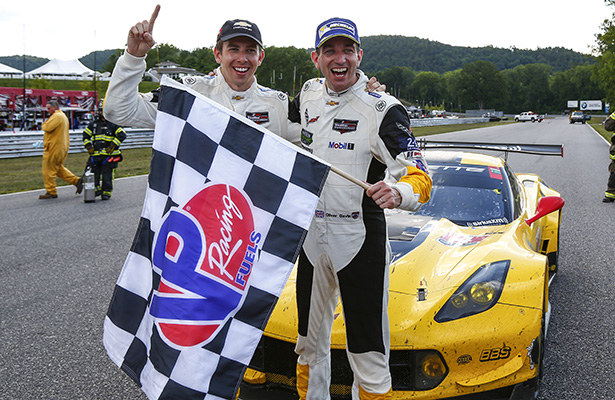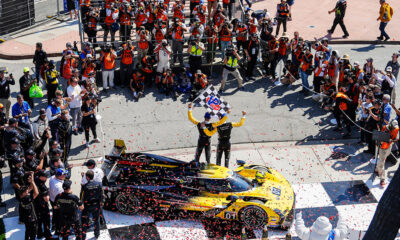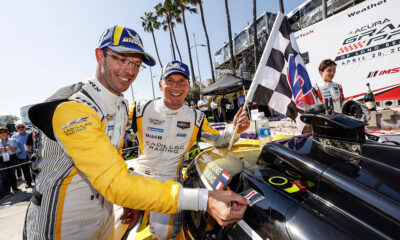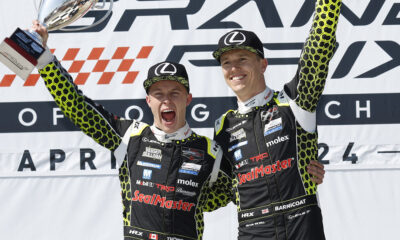
Photo: IMSA
Last weekend’s Northeast Grand Prix at Lime Rock Park marked a significant milestone and achievement in the history of Corvette Racing, with the factory Pratt & Miller squad achieving its 100th victory in top-level sports car racing competition.
Since the program’s inception in 1999, the Corvette C5-R, C6.R and C7.R have won just about everything possible in the world of GT racing, topped off with eight victories at Le Mans.
PODCAST: Doug Fehan on Corvette’s 100th Win
The 100th win at Lime Rock, achieved by Oliver Gavin and Tommy Milner in the No. 4 Corvette C7.R, came as the 60th 1-2 finish in the team’s history, with Gavin earning his 47th win with Corvette.
This makes the Englishman the most successful driver in the history of the program, after joining it in 2002.
“I’ll never forget that conversation that I had with Ron Fellows behind the podium at Watkins Glen [in 2001],” Gavin told Sportscar365. “I had just done a Grand-Am race with Jon Field, I finished on the podium, and there was Ron Fellows giving out the trophies.
“He was racing there that weekend in NASCAR. He gave the trophy and then he said, ‘Olly, have you got a second afterwards? I just want to have a chat.’
“I got off the podium, went around the back of the podium, and he [asked], ‘What are you doing next year?’ I said I wasn’t sure. He said, ‘I think there might be a spot that’s opening up in our lineup at Corvette Racing. Why don’t you give Doug Fehan a call?’
“And, I did. Off the back of that, I’m here 100 wins later and managed to secure them their 100th on Saturday. It’s just a bit mind-boggling really.”
While Gavin’s first Corvette win was at the 2002 Twelve Hours of Sebring, the first for the program as a whole came at Texas Motor Speedway in 2000, as explained by program manager Doug Fehan, who has been with the program since the beginning.
“We brought one car, we had been thumped for a year and a half by Viper,” Fehan told Sportscar365. “We got closer and closer, and we [went] down [to Texas].
“It was with Fellows and Andy Pilgrim, it was 117 degrees at race time, 7 p.m. at night, hotter than hell. It was going to be brutal, it was at a race track that neither one of us [Viper or Corvette] had been before, and so I knew that we had a best chance there, because they couldn’t have done any homework.
“It was mano a mano, engineering staff against engineering staff, driving team against driving team, pit crew against pit crew. We ended up lapping them for that first victory.”
The Texas race was part of the American Le Mans Series, in which Corvette found most of its success. Until the series’ merger in 2014, a Corvette Racing entry won 82 times.
On top of that, they have won nine times in the IMSA WeatherTech SportsCar Championship, eight times at Le Mans, and once in Grand-Am for the 2001 Rolex 24 at Daytona.
However, many of the ALMS victories came at a time in which the Corvettes ran relatively unchallenged, which put a question mark over the project’s financial viability at the time.
“For a couple of years there, we had pretty much run off most of the competition in the GT1 category,” Fehan said. “There were [times] that we were simply racing against ourselves, and that was for about a two-year period.
“Outsiders, and even those inside the corporation, said, ‘What are we doing, why are we spending this money to essentially race ourselves?’ They had to look at racing from a purely marketing perspective.
“What’s the difference if we put together a group of trailers and some show cars, assign them to dealerships, and we travel the United States doing dealer on-site shows to attract customers, or if we do the same thing and use a couple of race cars and we do it at race venues?
“That’s arguably far more exciting than [at] a dealer’s parking lot, and it’s essentially the same money. When they looked at it from that perspective, they [realized] it made some sense.
“Our apparel sales went up, our at-race attendance when up, our Corvette corrals showed an increase in attendance.
“There were no numbers that indicated we were having any less impact, just out there performing by ourselves. As a matter of fact, it was exactly the opposite. The impact was becoming greater.”
GT racing has since grown immensely, and while this has understandably made it more difficult for Corvette to win, it means that each victory is sweeter than before.
“When you look at all the other series that are out there and quite successful in their own right, the closest and most professional competition, the best-funded competition, is right here in North America at the WeatherTech Championship,” Fehan said.
“The effort put forth by Ferrari, Porsche, BMW and Corvette, and the new addition this year of Ford, it’s the best GT racing in the world, bar none. Period.”
Fehan believes that the growth of GT racing is partly down to Corvette’s own success a few years before.
“When no other manufacturer was interested in GT racing, Corvette stayed because they saw the value in it,” he said. “At that period of time, it opened some eyes. It opened eyes at Porsche, Ferrari, BMW, and at Aston Martin.
“They had to step back and say, ‘Wait a minute, these guys are out there and they’ve got this whole market all to themselves.’ This is the other edge of the sword. It wasn’t like, ‘Oh they’re just racing themselves,’ it was, ‘They’ve got this whole market. We need a piece of that!’
“And then you watch it grow into what it is today. That was really the tipping point, going from no competition to where we are today because everybody realized what you could do when they saw us do it. “
The team believes that one of the main factors that has allowed it to continue its effort so much longer than expected is the fan interaction.
This is partly because of the enthusiasts at the races, but also through the ability to sell road-going Corvettes off the back of on-track successes.
“I don’t think that there’s another program out there that does it quite as well as we do,” Gavin said.
“You see that every weekend with the Corvette corrals; the passion of the fans, of the owners and the people who are there just to support us. We always seem to have the longest lines at all the autograph sessions.
“You always seem to have this great following, and real enthusiasm, not just for the race car, but actually for the Corvette itself.”
“There is a reason we sell 35,000 cars a year, and that’s because we build a tremendous product that is truly high-performance,” Fehan said.
“If you look at Corvettes today – the Z06 – acceleration rate, cornering capability, braking capability, you’ve got to spend a million dollars to buy a production road car that can beat a Corvette on those three things.
“You make a better road car, you make a better race car, that makes a better road car, that makes a better race car. It’s what I call ‘cascade engineering’. We’ve been able to do that, and all those things add up.”
Even though the magical number of 100 has been reached, Gavin already knows his next goals.
“You get to a milestone and that’s fantastic, but then there’s always the next one you want to get to,” he said.
“That would be to get three in a row at Daytona, three in a row at Sebring, to go back to Le Mans again and get our ninth victory.”
John Dagys and Ryan Myrehn contributed to this report























